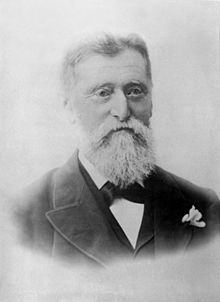Thomas Kirk (botanist)
| Thomas Kirk | |
|---|---|

Thomas Kirk (botanist)
|
|
| Born | 18 January 1828 Coventry, Warwickshire, England |
| Died | 8 March 1898 (aged 70) Plimmerton, New Zealand |
| Resting place | Karori Cemetery, Wellington |
| Nationality | British |
| Occupation | Botanist writer teacher Public servant Churchman Surveyor |
| Organization | Auckland Institute |
| Known for |
Botanical expeditions |
| Spouse(s) | Sarah Jane Mattocks (married 1850) |
| Children | 9 |
| Parent(s) | George Kirk Sarah West |
| Relatives |
Lily May Atkinson (daughter) Harry Borrer Kirk (son) Cybele Ethel Kirk (daughter) |
Botanical expeditions
Thomas Kirk (18 January 1828 – 8 March 1898) was an English-born botanist, teacher, public servant, writer and churchman who moved to New Zealand with his wife and four children in late 1862. The New Zealand government commissioned him in 1884 to compile a report on the indigenous forests of the country and appointed him as chief conservator of forests the following year. He published 130 papers in botany and plants including The Durability of New Zealand Timbers, The Forest Flora of New Zealand and Students' Flora of New Zealand.
Thomas was the son of a Coventry nurseryman, George Kirk, and Sarah West, a florist. As a consequence of his parents' involvement in nursery work, he displayed a keen interest in botany, and later worked at a timber mill in Coventry. In 1850 he married a silk marker, Sarah Jane Mattocks. Poor health and financial problems led to his emigrating to Auckland, arriving with his family on 9 February 1863.
Soon after his arrival Kirk started on a collection of botanical specimens. He prepared a set of ferns and other plants for the New Zealand Exhibition which was held in Dunedin in January 1865. In the following year he worked as surveyor, and in 1868 became a meteorological observer in Auckland. In the same year he was appointed secretary of the Auckland Institute and took on the position of museum curator, an office he filled for the next five years.
Kirk took part in a number of botanical expeditions, writing and publishing reports on the results. These included Great Barrier and Little Barrier Islands in 1867, the east coast of Northland in 1868, the Thames goldfields in 1869, the Waikato district in 1870, and Rotorua and Taupo in 1872. Between 1869 and 1873 he found time to serve as secretary and treasurer of the Auckland Acclimatisation Society, teaching botany at the Auckland College and Grammar School and became an elected fellow of the Linnean Society of London in 1871.
In early 1874 he moved to Wellington and until 1880 lectured there in natural sciences at Wellington College, which was then affiliated to the University of New Zealand. Kirk proved to be a skilled teacher, enjoying the respect of staff and students. In 1874 he became a member of the Wellington Philosophical Society, serving as president in 1878 and 1879.
...
Wikipedia
